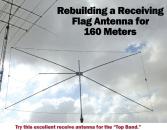Introduction
Receiving wire antennas are useful on 160 and 80 meters, where rotatable antennas are impractical for all but a few lucky hams. The noise is so high on these bands that efficiency can be sacrificed with a negligible effect on receive signal to noise ratio.
Articles
Beverage
- The Classic Beverage Antenna, Revisited
QST January 1982, pp. 11-17
An update on an historical 1922 QST article describing the “definitive” receiving antenna. - The Wave Antenna For 200 Meter Reception
QST November 1922, pp. 7-15
The original article by Mr. Beverage that started a legend.
EWE
- Is this Ewe for You?
QST February 1995, pp. 31-33
Feedback QST April 1995, p 75
Here's a really simple receiving antenna for 80 and 160-meter Dxing. - More EWEs for You
QST January 1996, pp. 32-34
You've seen the basic EWE, now you can have switchable, directional EWEs!
K9AY Loop
- The K9AY Terminated Loop--A Compact, Directional Receiving Antenna
QST September 1997, pp. 43-46
Wish you had enough room for an effective low-band receiving antenna? You do! This four-direction system by Gary Breed K9AY fits in a 30-foot circle! - Comments on The K9AY Terminated Loop
QST April 1998, pp. 77-78
Technical Correspondence on the Gary Breed K9AY Terminated Loop. - Hum Problems When Switching The K9AY Loops
QST May 1998, p. 73
Technical Correspondence on the Gary Breed K9AY Terminated Loop.
Receiving Flag Antennas
Flag antennas are ground independent receiving antennas optimized for a good front to back ratio on one or more ham bands. They are typically as small as possible to allow use in small back yards or to be mounted on a rotator. The small size results in a very low gain that makes them unsuitable for transmit as well as highly susceptible to common mode noise. But, if properly done, they may dramatically improve receive performance on the low bands by nulling noise via the deep null off the back of the antenna. Adjusting the termination resistor will optimize the depth of the null and a rotator will allow precise aiming of the null. Normally vertically polarized, they can also be mounted horizontally to null out vertically polarized line noise. They can be suspended between strategically located trees.
Rebuilding a Receiving Flag Antenna for 160M
Steve Lawrence WB6RSE July 2015 QST pp 35-38
Flags, Pennants, and other Ground Independent Low Band Receiving Antennas
Earl Cunningham K6SE July 2000 pp 34-37
Technology >> Radio Technology Topics >> Antennas >> Antenna Projects >> MF/HF Receiving Wire Antennas





